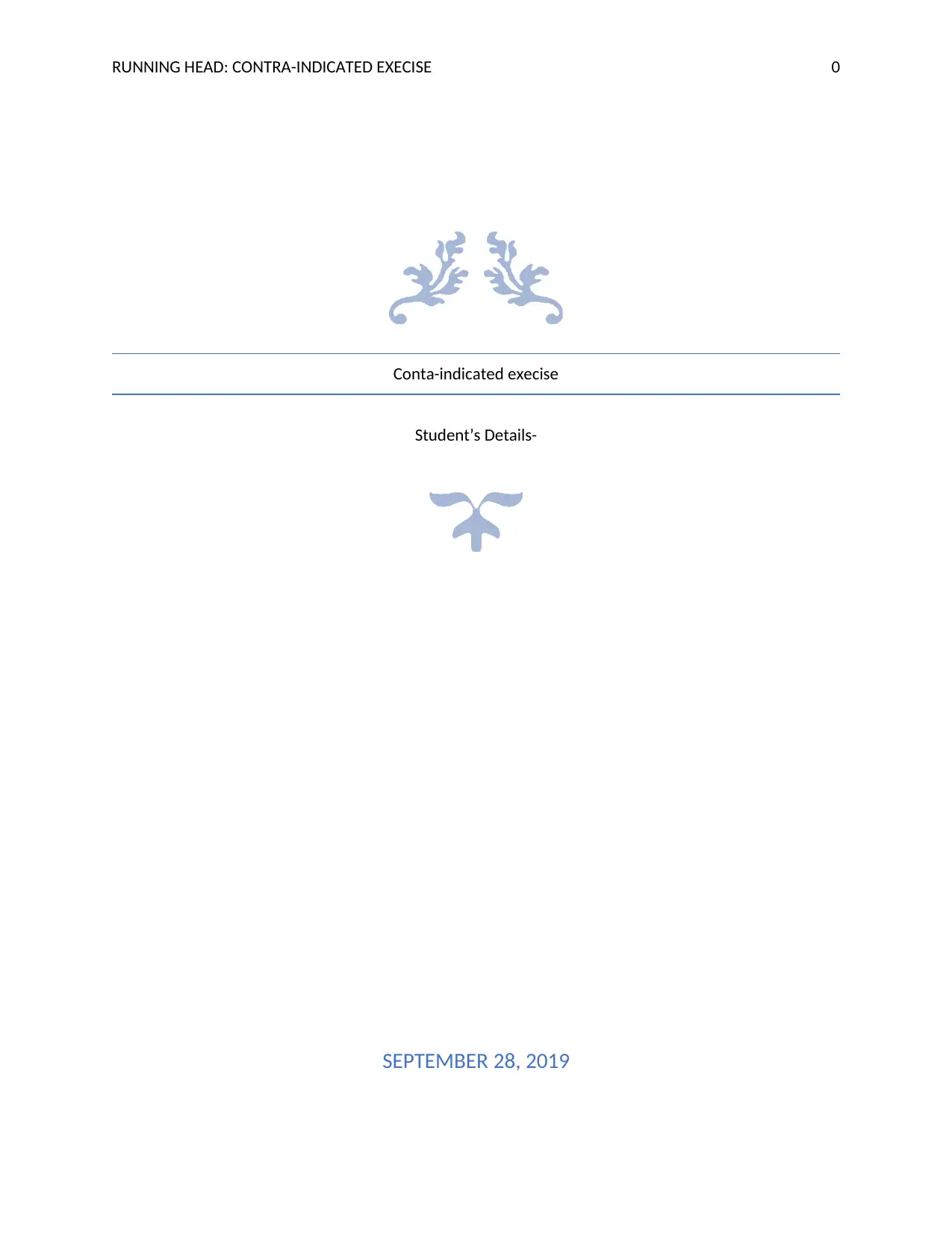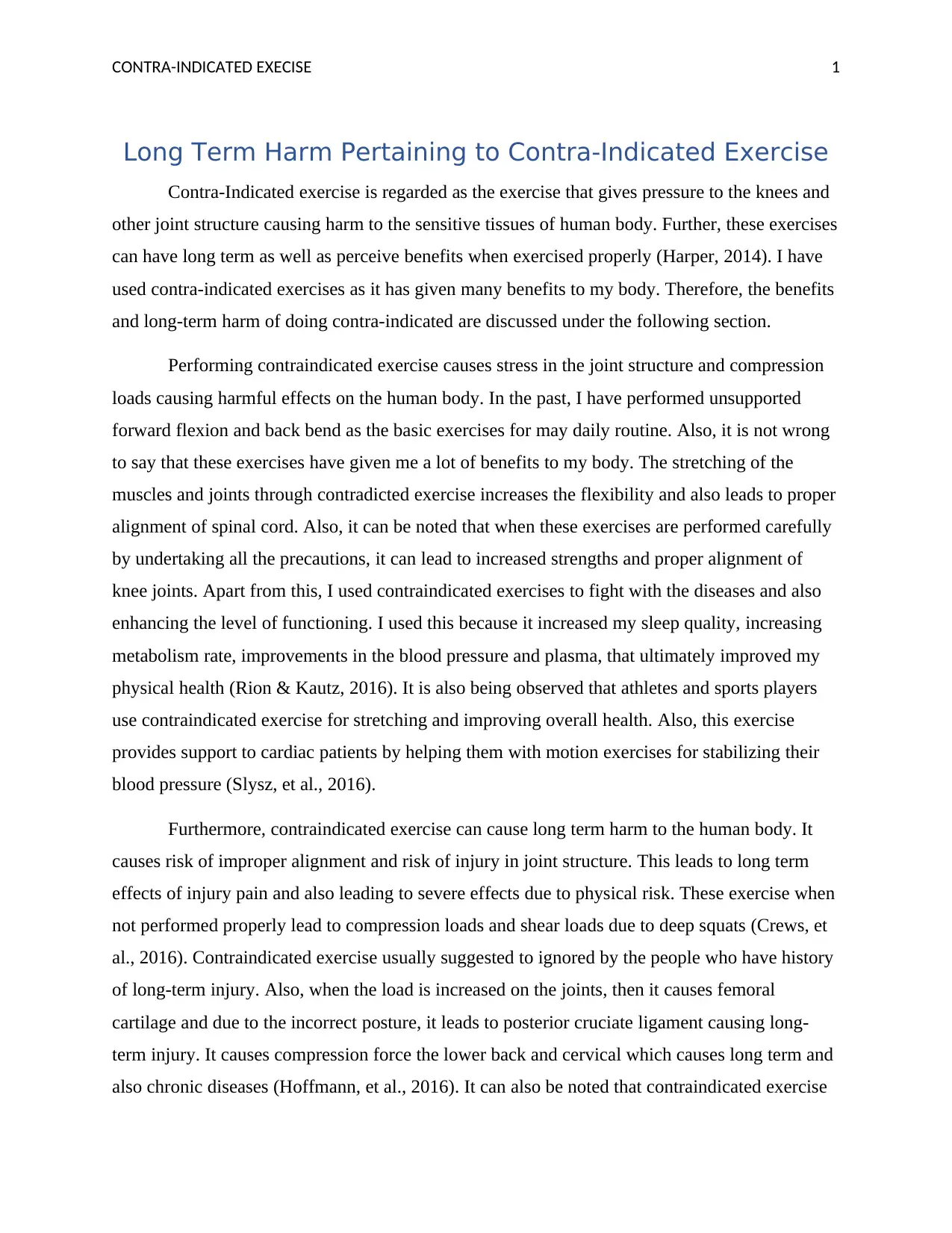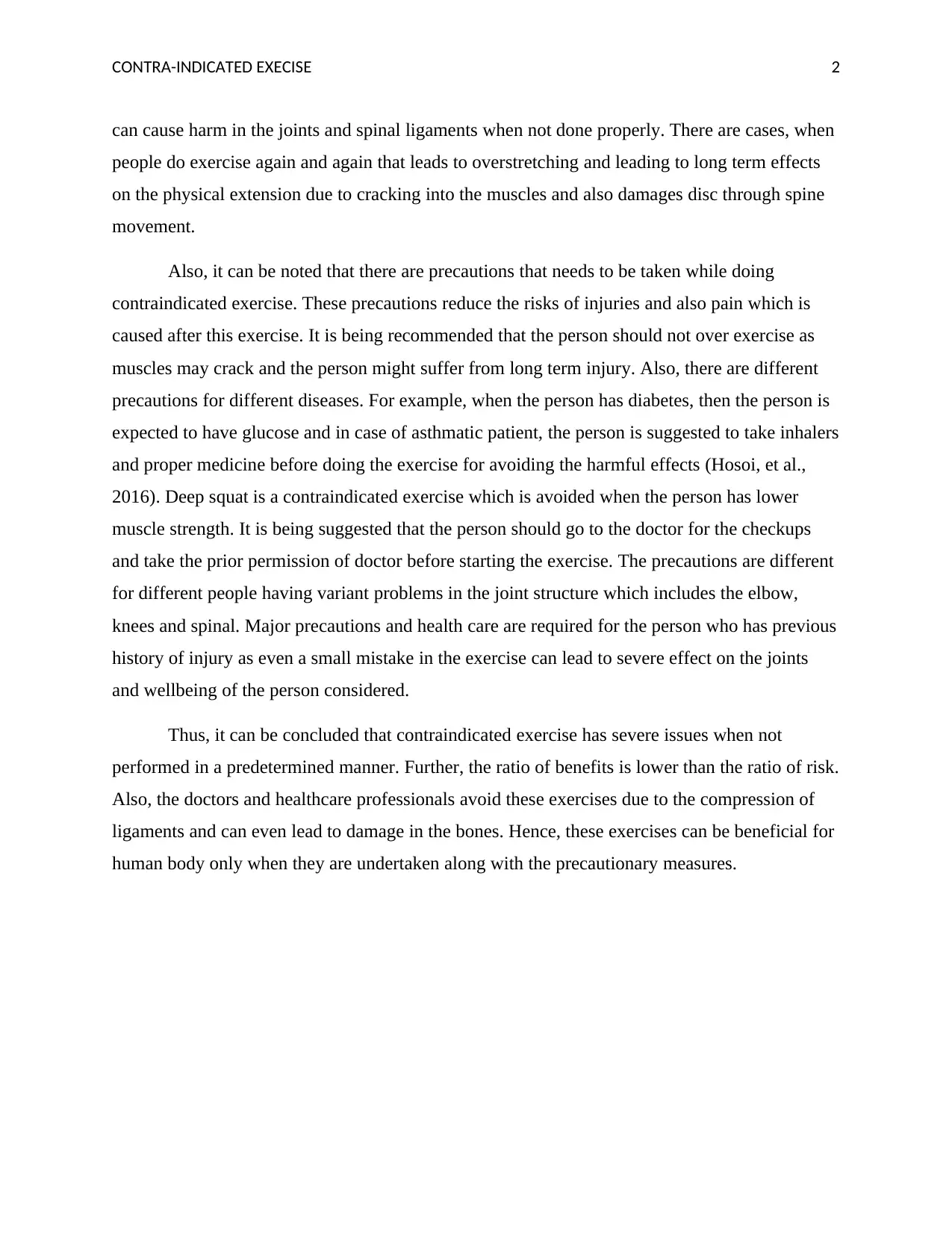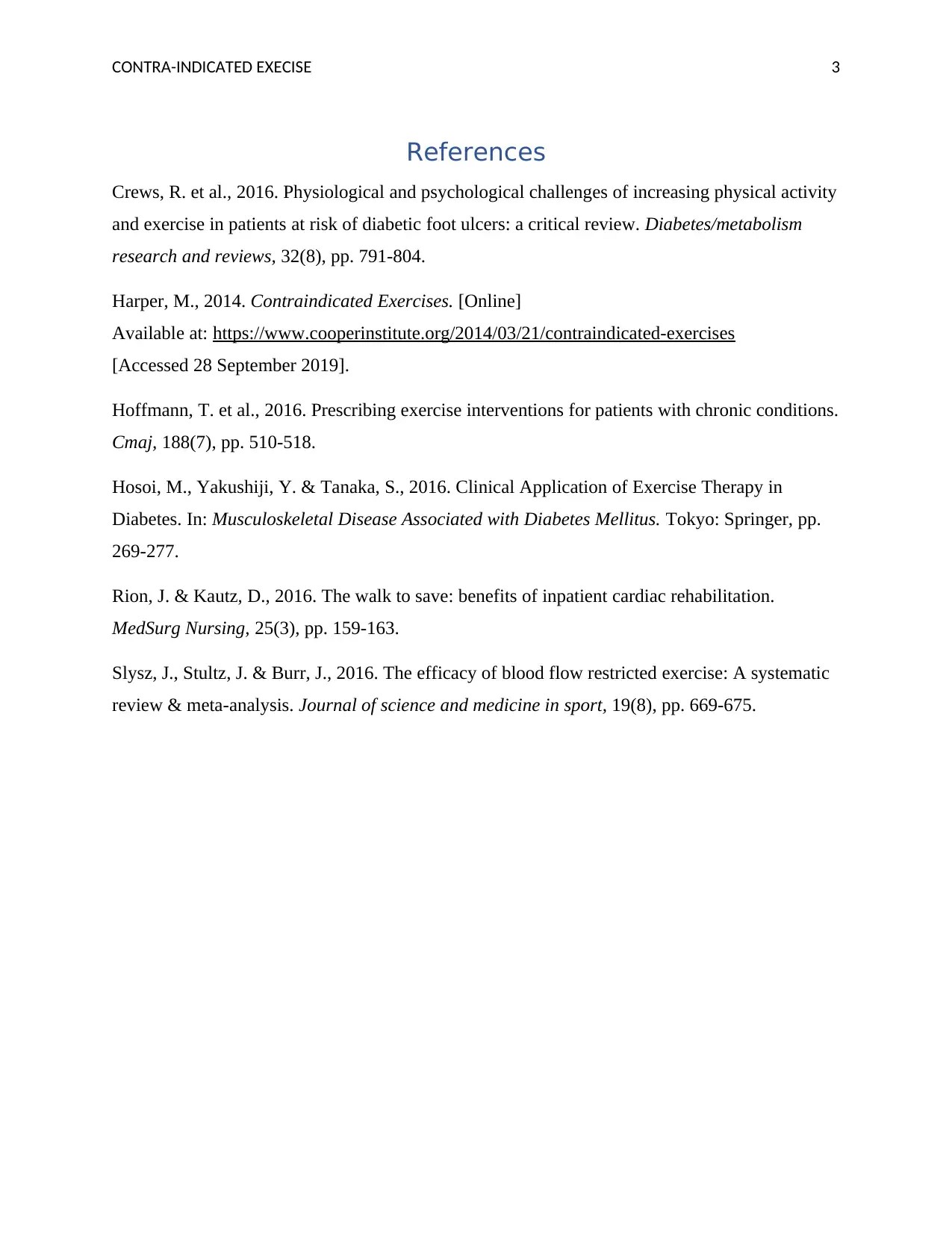Contra-Indicated Exercise: Exploring Long-Term Harm and Benefits
VerifiedAdded on 2022/10/11
|4
|1076
|12
Essay
AI Summary
This essay examines contra-indicated exercises, defining them as those that place stress on joints and tissues. It explores both the perceived benefits, such as increased flexibility and spinal alignment, and the potential long-term harm, including risks of injury, compression loads, and damage to joint structures. The essay highlights the importance of precautions, such as avoiding overexertion and consulting healthcare professionals, especially for individuals with pre-existing conditions or a history of injury. It emphasizes that while these exercises may offer certain advantages, the risks often outweigh the benefits, particularly if performed incorrectly. The essay concludes that contra-indicated exercises should be approached cautiously, with a strong emphasis on safety and informed decision-making.

RUNNING HEAD: CONTRA-INDICATED EXECISE 0
Conta-indicated execise
Student’s Details-
SEPTEMBER 28, 2019
Conta-indicated execise
Student’s Details-
SEPTEMBER 28, 2019
Paraphrase This Document
Need a fresh take? Get an instant paraphrase of this document with our AI Paraphraser

CONTRA-INDICATED EXECISE 1
Long Term Harm Pertaining to Contra-Indicated Exercise
Contra-Indicated exercise is regarded as the exercise that gives pressure to the knees and
other joint structure causing harm to the sensitive tissues of human body. Further, these exercises
can have long term as well as perceive benefits when exercised properly (Harper, 2014). I have
used contra-indicated exercises as it has given many benefits to my body. Therefore, the benefits
and long-term harm of doing contra-indicated are discussed under the following section.
Performing contraindicated exercise causes stress in the joint structure and compression
loads causing harmful effects on the human body. In the past, I have performed unsupported
forward flexion and back bend as the basic exercises for may daily routine. Also, it is not wrong
to say that these exercises have given me a lot of benefits to my body. The stretching of the
muscles and joints through contradicted exercise increases the flexibility and also leads to proper
alignment of spinal cord. Also, it can be noted that when these exercises are performed carefully
by undertaking all the precautions, it can lead to increased strengths and proper alignment of
knee joints. Apart from this, I used contraindicated exercises to fight with the diseases and also
enhancing the level of functioning. I used this because it increased my sleep quality, increasing
metabolism rate, improvements in the blood pressure and plasma, that ultimately improved my
physical health (Rion & Kautz, 2016). It is also being observed that athletes and sports players
use contraindicated exercise for stretching and improving overall health. Also, this exercise
provides support to cardiac patients by helping them with motion exercises for stabilizing their
blood pressure (Slysz, et al., 2016).
Furthermore, contraindicated exercise can cause long term harm to the human body. It
causes risk of improper alignment and risk of injury in joint structure. This leads to long term
effects of injury pain and also leading to severe effects due to physical risk. These exercise when
not performed properly lead to compression loads and shear loads due to deep squats (Crews, et
al., 2016). Contraindicated exercise usually suggested to ignored by the people who have history
of long-term injury. Also, when the load is increased on the joints, then it causes femoral
cartilage and due to the incorrect posture, it leads to posterior cruciate ligament causing long-
term injury. It causes compression force the lower back and cervical which causes long term and
also chronic diseases (Hoffmann, et al., 2016). It can also be noted that contraindicated exercise
Long Term Harm Pertaining to Contra-Indicated Exercise
Contra-Indicated exercise is regarded as the exercise that gives pressure to the knees and
other joint structure causing harm to the sensitive tissues of human body. Further, these exercises
can have long term as well as perceive benefits when exercised properly (Harper, 2014). I have
used contra-indicated exercises as it has given many benefits to my body. Therefore, the benefits
and long-term harm of doing contra-indicated are discussed under the following section.
Performing contraindicated exercise causes stress in the joint structure and compression
loads causing harmful effects on the human body. In the past, I have performed unsupported
forward flexion and back bend as the basic exercises for may daily routine. Also, it is not wrong
to say that these exercises have given me a lot of benefits to my body. The stretching of the
muscles and joints through contradicted exercise increases the flexibility and also leads to proper
alignment of spinal cord. Also, it can be noted that when these exercises are performed carefully
by undertaking all the precautions, it can lead to increased strengths and proper alignment of
knee joints. Apart from this, I used contraindicated exercises to fight with the diseases and also
enhancing the level of functioning. I used this because it increased my sleep quality, increasing
metabolism rate, improvements in the blood pressure and plasma, that ultimately improved my
physical health (Rion & Kautz, 2016). It is also being observed that athletes and sports players
use contraindicated exercise for stretching and improving overall health. Also, this exercise
provides support to cardiac patients by helping them with motion exercises for stabilizing their
blood pressure (Slysz, et al., 2016).
Furthermore, contraindicated exercise can cause long term harm to the human body. It
causes risk of improper alignment and risk of injury in joint structure. This leads to long term
effects of injury pain and also leading to severe effects due to physical risk. These exercise when
not performed properly lead to compression loads and shear loads due to deep squats (Crews, et
al., 2016). Contraindicated exercise usually suggested to ignored by the people who have history
of long-term injury. Also, when the load is increased on the joints, then it causes femoral
cartilage and due to the incorrect posture, it leads to posterior cruciate ligament causing long-
term injury. It causes compression force the lower back and cervical which causes long term and
also chronic diseases (Hoffmann, et al., 2016). It can also be noted that contraindicated exercise

CONTRA-INDICATED EXECISE 2
can cause harm in the joints and spinal ligaments when not done properly. There are cases, when
people do exercise again and again that leads to overstretching and leading to long term effects
on the physical extension due to cracking into the muscles and also damages disc through spine
movement.
Also, it can be noted that there are precautions that needs to be taken while doing
contraindicated exercise. These precautions reduce the risks of injuries and also pain which is
caused after this exercise. It is being recommended that the person should not over exercise as
muscles may crack and the person might suffer from long term injury. Also, there are different
precautions for different diseases. For example, when the person has diabetes, then the person is
expected to have glucose and in case of asthmatic patient, the person is suggested to take inhalers
and proper medicine before doing the exercise for avoiding the harmful effects (Hosoi, et al.,
2016). Deep squat is a contraindicated exercise which is avoided when the person has lower
muscle strength. It is being suggested that the person should go to the doctor for the checkups
and take the prior permission of doctor before starting the exercise. The precautions are different
for different people having variant problems in the joint structure which includes the elbow,
knees and spinal. Major precautions and health care are required for the person who has previous
history of injury as even a small mistake in the exercise can lead to severe effect on the joints
and wellbeing of the person considered.
Thus, it can be concluded that contraindicated exercise has severe issues when not
performed in a predetermined manner. Further, the ratio of benefits is lower than the ratio of risk.
Also, the doctors and healthcare professionals avoid these exercises due to the compression of
ligaments and can even lead to damage in the bones. Hence, these exercises can be beneficial for
human body only when they are undertaken along with the precautionary measures.
can cause harm in the joints and spinal ligaments when not done properly. There are cases, when
people do exercise again and again that leads to overstretching and leading to long term effects
on the physical extension due to cracking into the muscles and also damages disc through spine
movement.
Also, it can be noted that there are precautions that needs to be taken while doing
contraindicated exercise. These precautions reduce the risks of injuries and also pain which is
caused after this exercise. It is being recommended that the person should not over exercise as
muscles may crack and the person might suffer from long term injury. Also, there are different
precautions for different diseases. For example, when the person has diabetes, then the person is
expected to have glucose and in case of asthmatic patient, the person is suggested to take inhalers
and proper medicine before doing the exercise for avoiding the harmful effects (Hosoi, et al.,
2016). Deep squat is a contraindicated exercise which is avoided when the person has lower
muscle strength. It is being suggested that the person should go to the doctor for the checkups
and take the prior permission of doctor before starting the exercise. The precautions are different
for different people having variant problems in the joint structure which includes the elbow,
knees and spinal. Major precautions and health care are required for the person who has previous
history of injury as even a small mistake in the exercise can lead to severe effect on the joints
and wellbeing of the person considered.
Thus, it can be concluded that contraindicated exercise has severe issues when not
performed in a predetermined manner. Further, the ratio of benefits is lower than the ratio of risk.
Also, the doctors and healthcare professionals avoid these exercises due to the compression of
ligaments and can even lead to damage in the bones. Hence, these exercises can be beneficial for
human body only when they are undertaken along with the precautionary measures.
⊘ This is a preview!⊘
Do you want full access?
Subscribe today to unlock all pages.

Trusted by 1+ million students worldwide

CONTRA-INDICATED EXECISE 3
References
Crews, R. et al., 2016. Physiological and psychological challenges of increasing physical activity
and exercise in patients at risk of diabetic foot ulcers: a critical review. Diabetes/metabolism
research and reviews, 32(8), pp. 791-804.
Harper, M., 2014. Contraindicated Exercises. [Online]
Available at: https://www.cooperinstitute.org/2014/03/21/contraindicated-exercises
[Accessed 28 September 2019].
Hoffmann, T. et al., 2016. Prescribing exercise interventions for patients with chronic conditions.
Cmaj, 188(7), pp. 510-518.
Hosoi, M., Yakushiji, Y. & Tanaka, S., 2016. Clinical Application of Exercise Therapy in
Diabetes. In: Musculoskeletal Disease Associated with Diabetes Mellitus. Tokyo: Springer, pp.
269-277.
Rion, J. & Kautz, D., 2016. The walk to save: benefits of inpatient cardiac rehabilitation.
MedSurg Nursing, 25(3), pp. 159-163.
Slysz, J., Stultz, J. & Burr, J., 2016. The efficacy of blood flow restricted exercise: A systematic
review & meta-analysis. Journal of science and medicine in sport, 19(8), pp. 669-675.
References
Crews, R. et al., 2016. Physiological and psychological challenges of increasing physical activity
and exercise in patients at risk of diabetic foot ulcers: a critical review. Diabetes/metabolism
research and reviews, 32(8), pp. 791-804.
Harper, M., 2014. Contraindicated Exercises. [Online]
Available at: https://www.cooperinstitute.org/2014/03/21/contraindicated-exercises
[Accessed 28 September 2019].
Hoffmann, T. et al., 2016. Prescribing exercise interventions for patients with chronic conditions.
Cmaj, 188(7), pp. 510-518.
Hosoi, M., Yakushiji, Y. & Tanaka, S., 2016. Clinical Application of Exercise Therapy in
Diabetes. In: Musculoskeletal Disease Associated with Diabetes Mellitus. Tokyo: Springer, pp.
269-277.
Rion, J. & Kautz, D., 2016. The walk to save: benefits of inpatient cardiac rehabilitation.
MedSurg Nursing, 25(3), pp. 159-163.
Slysz, J., Stultz, J. & Burr, J., 2016. The efficacy of blood flow restricted exercise: A systematic
review & meta-analysis. Journal of science and medicine in sport, 19(8), pp. 669-675.
1 out of 4
Your All-in-One AI-Powered Toolkit for Academic Success.
+13062052269
info@desklib.com
Available 24*7 on WhatsApp / Email
![[object Object]](/_next/static/media/star-bottom.7253800d.svg)
Unlock your academic potential
Copyright © 2020–2025 A2Z Services. All Rights Reserved. Developed and managed by ZUCOL.

